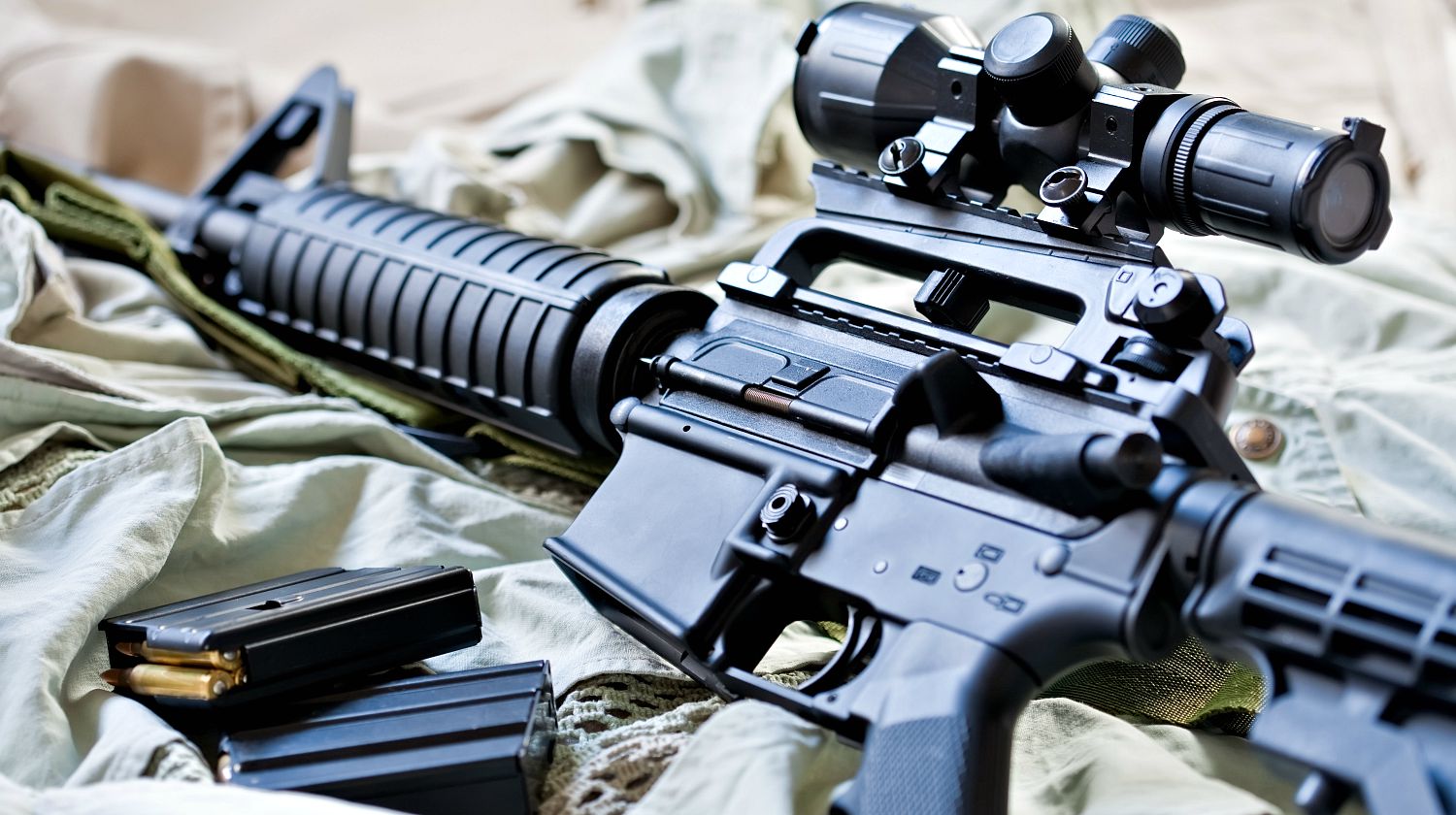Featured
AR-15 Basics: A Guide To The AR-15 Platform
Published
1 year agoon
By
Mike Garman
Know all about the AR-15 and arm yourself with facts!
RELATED: Rifle Shooting Tips & Techniques | 11 Surprising Things New Rifle Shooters Need To Know
In this article
- Introduction to AR-15
- A Brief History of the AR-15
- AR-15 Nomenclature
- Parts of the AR-15 Rifle
- Direct Impingement AR-15
- Gas Piston
- Figuring Out Which AR-15 Is Best for You
- AR 15 Caliber
- AR-15 Gas System
- Upper Receiver
- AR Short Barrel
AR-15 | An Assault Rifle of Choice
Introduction to AR-15

Original AR-15 Photo by Internet Movie Firearms Database
The AR-15 assault rifle is a hot topic lately, with legislators looking to ban or limit sales due to its latest reported links to gun violence. Even the Bureau of Alcohol, Tobacco, Firearms, and Explosives is trying to ban a very popular type of ammunition for it.
Yet, the AR-15 is arguably the most popular sporting rifle in the country. When you start talking about the AR-15, an argument will start about which is the better rifle: the AR-15 or the AK-47/74.
While both have their good and bad points, I prefer the AR series for a couple of reasons. One being, the M16/M4 is the standard battle rifle for the U.S. Armed Forces and federal, state, and local law enforcement.
In most cases, parts for the M16/M4 are interchangeable with the AR-15. This means that when SHTF, you will find parts, magazines, and ammunition anywhere.
There are differences between the military and civilian versions of the rifle. We’ll talk about those, as well as the differences found among the AR family of weapons.
Before we get into the AR-15, I feel it’s important to know a little bit about the M16/M4 and its history.
A Brief History of the AR-15
We’ve all seen the M-16 on television or in the movies. For years, most people assumed that the AR-15 is the semi-automatic version of the M-16.
In 1959, ArmaLite sold its rights to the AR-15 to Colt. The AR designation stayed, but contrary to popular belief, AR does not stand for Assault Rifle.
It meant and still means Armalite AR 15 Rifle. The AR-15 was first adopted, in 1962, by the United States Air Force for their security police; the AR-15 received the designation M16.
The U.S. Army began to field the XM16E1 in 1965, with the majority of them going to the Republic of Vietnam Army. It included the newly formed Airmobile Divisions, chiefly the 1st Air Cavalry Division.
There were a lot of problems with the first M16s. Mostly, failures to eject spent rounds that caused the weapon to jam.
A good friend who fought in Vietnam told me that when he first used an M-16, it jammed often and usually at the absolute worst time.
The problem turns out to be the powder used in the round, as well as some other reliability problems. They fixed it and the M-16A1 was born.
A2 followed the A1 and later developed into the M4. The currently issued rifle is the M4 carbine.
The M4 carbine has a three-round burst firing mode. Meanwhile, the M4A1 carbine has a fully automatic firing mode.
Colt’s Manufacturing LLC retained the Colt AR-15 designation. They offered it for sale to civilian and law enforcement as a semi-automatic version of the M-16.
AR-15 Nomenclature
Disassembled parts of the bolt carrier group from an AR-15 rifle Photo by Firearm History
Semi-automatic AR-15s for sale to civilians are internally different from the fully-automatic M16. On the outside, they appear almost identical. With the upper receiver only a little different (having an area milled out for clearance).
On the inside, though, they are apples and oranges, being the hammer and trigger are of a different design. The bolt carrier and internal lower receiver of semi-automatic assault rifles are different.
In fact, the firing mechanisms are not interchangeable. This was to meet ATF requirements so civilian weapons are easy to convert to full-automatic.
In the late 1970s and early 1980s, modifications to the AR-15 were rampant. That was with “Drop In Auto Sear” or “lightning-link” conversions to fully automatic.
But, these were very straightforward modifications. And, unless using registered and transferable parts made before May 19, 1986, are now illegal.
In 1986, The Firearm Owners Protection Act (Public Law 99-308) redefined a machine gun. It was to include individual components used to convert a semi-automatic firearm to full-automatic.
I cannot stress this enough. If you convert an AR-15 to fully automatic and you get caught, you are going to prison. The ATF’s Firearms Enforcement Division are very serious about this.
Having said that, there are parts that are interchangeable. Having them installed on your AR-15 does not make it a machine gun under federal law though.
The full auto bolt and bolt carrier are interchangeable, and having one in your rifle is legal.
Parts of the AR-15 Rifle
https://twitter.com/AMF_Defense/status/1055802121940099072
One thing to note on the interchangeability of AR 15 parts, the AR-15 comes in two variants: Commercial and Mil-Spec.
Over the course of this article, I’ll point out the differences between AR-15 and M16/M4 parts and Mil-Spec vs. Commercial. Regardless, the various types function in the same way.
The AR-15 consists of three major components: the upper receiver, the bolt and bolt carrier, and the lower receiver. Two pins hold together the upper and lower receiver.
Pushing the rearmost pinout will allow the upper receiver to tilt forward for field cleaning. Pushing both pins out then will allow the upper and lower assemblies to separate.
Direct Impingement AR-15
The difference between Gas Piston and Direct Impingement technology for an AR-15# http://t.co/UZ7zLCy1z1 pic.twitter.com/lIcyACwgMo
— Stag Arms (@StagArms) April 21, 2015
There are two basic operating systems for the AR-15. Direct Impingement and Gas Piston, with the most common being Direct Impingement. All the ones I own are Direct Impingement.
Direct impingement is the original technology used in the M16 and its variants devised by Eugene Stoner in the ’50s. Propellant gas from the fired round goes through a small hole located in the barrel.
This gas is then channeled through a very small tube where it comes in contact (or impinge) to the bolt carrier.
At this point, the gas pushes to the rear of the rifle, forcing the bolt carrier back where the spent case comes out. As the bolt carrier moves rearward it pushes the buffer back, compressing a spring.
It is then pushed forward by spring-loaded action and strips an unspent round from the magazine. After that, it goes back straight into the chamber of the barrel.
I fired hundreds of rounds on purpose through one of my ARs without cleaning it. I wanted to see if I could induce a malfunction and never could.
Gas Piston
Adjustable AR-15 Gas Piston System by Syrac Ordnance http://t.co/YYWVfe8d4c pic.twitter.com/ZdG4YjB2CH
— NoKick.com (@Nokickcom) August 18, 2015
A gas piston is the same operation used by the AK-47. While it is more or less the same as direct impingement systems, there are a few differences.
Firing a round again feeds propellant gases into the barrel. But instead of going into a tube as it is in a direct impingement system, it stays in a separate cylinder.
This cylinder holds a piston. As the gas moves the piston, it, in turn, pushes the bolt carrier rearward.
Then it extracts the spent rounds and feeds in the new round. The bolt carrier pushes forward to the closed position by a spring, as with direct impingement.
RELATED: Best AR15 Hacks To Unlock Your Gun’s True Potential
Figuring Out Which AR-15 Is Best for You

Which is better, is another question that is sure to start an argument. My only comment is the military uses direct impingement and the vast majority of the civilian AR-15s are direct impingement.
Let’s examine a direct impingement AR-15 in detail.
AR 15 Caliber
https://twitter.com/DangerClosePics/status/801695330458701824
Starting from the front and working our way back, the example shown below is a stripped AR-15 that uses a 300 AAC Blackout, 7.62×35mm cartridge. Other than the caliber, the component parts and operation are the same as a standard AR-15 in .223/5.56.
Starting with the barrel, the end—unless the barrel is target crowned as the .308 AR-10 shown above—threads at 1/2×28, which is standard for 5.56/.223. It will vary with other calibers.
The one shown is for a 300 Blackout and threaded at 5/8×24. This particular barrel is stainless steel.
The flash suppressor shown above is a shorty muzzle brake and is also threaded for a suppressor. Next, are the gas block and gas tube.
Under the gas block, there are holes in the barrel for the gas to escape. Some gas blocks are adjustable; these adjustments allow you to control the amount of gas and in turn control cycling and operation.
The one shown is not adjustable.
AR-15 Gas System
GORILLA MFG AR-15 AAC .300 Black Out 16" Barrel – Pistol Gas System – 1:8https://t.co/UBMFWN7Sjd pic.twitter.com/IzcZhUqMlC
— GorillaMachining (@GorillaMchining) January 9, 2018
The forward handguard covers the gas tube and barrel. There are a huge number of options for the hand guard and it is really up to you.
One thing to keep in mind is where the gas block is and the length of the gas tube. This will determine the handguard style that you can use.
Upper Receiver
How to Build an AR-15 Upper Receiver: Ultimate Visual Guidehttps://t.co/ZtWdlDdmuB pic.twitter.com/RciELxXnKt
— Pew Pew Tactical (@pewpewtactical) January 9, 2017
Next is the upper receiver. There are many options but they are all more or less the same. The barrel connects with the upper receiver.
It contains the ejection port, in some cases the forward assist, charging handle, and the bolt, and bolt carrier. Some upper receivers have an integral carry handle and some have rails.
Next are the bolt, bolt carrier, and charging handle. This is an example of the difference between the full auto bolt carrier and the civilian version.
As shown below there is a notable difference between the two.
https://twitter.com/2DayBuyBooks/status/772288544526180352
The charging handle moves the bolt carrier rearward to charge the weapon. There are some options for the charging handle. Shown is a standard one alongside one with an extended ambidextrous latch.
GORILLA MFG AR-15 Extended Charging Handle Latchhttps://t.co/pK6cfHfFcr pic.twitter.com/h7tqz3YSV4
— GorillaMachining (@GorillaMchining) January 11, 2018
The upper receiver is not considered a firearm and therefore is not controlled. You can order one and have it shipped directly to your home regardless of the length. But, anything less than 16 inches becomes a short barreled rifle when mounted on a lower receiver with a stock.
This does not apply to an AR-15 pistol with a SIG style brace. The National Fire Arms Act (NFA) controls the short barreled rifle which you must register. Applicable paperwork, tax stamp, and all.
AR Short Barrel
@Dwell_On_This Nice short barrel in your pic, I just got one also. Well, technically a ar-15 pistol with an arm brace pic.twitter.com/SwixZgIkff
— Brent (@gunmaster0702) July 21, 2014
Simply having a short barreled upper is not in itself illegal. But, if you have a short barreled upper and a standard 16-inch barreled AR-15 and got caught with both, you could be in a lot of trouble.
You can easily convert a standard AR-15 to a short barreled rifle that you have not registered. There is a case law that reflects the ATF’s position on this subject.
Upper receivers all have the same basic function. They are also made from metal like aluminum, either cast or billet, titanium, or a composite like carbon fiber.
You can buy it as a stripped unit, assembled, or as a complete upper as mentioned above. In part two of this series, I’ll be discussing the lower receiver and the AR’s ammunition.
Know why the AR-15 rifle is the most popular gun in the U.S. in this video by Seeker:
The AR-15 is under some fire these days and it's not sitting well with gun owners. So arm yourself with the knowledge of this firearm now to get your facts and opinions straight!
What do you think about the AR-15 and its design? Share your thoughts in the comments section below!
Up Next:
- Purchasing an AR-15 | A Buyer’s Guide to Not Getting Ripped Off
- Best Home Defense Guns | When The Cops Are Minutes Away
- AR-15 Basics: Shooting the AR-15

Editor’s Note: This post was originally published on June 21, 2018, and has been updated for quality and relevancy.
You may like

CZ 75 SP01 Tactical Gun Review | Gun Carrier

PODCAST: Gun Law Changes All Across America Right Now

PODCAST: How to Win Olympic Gold

PODCAST: 50 Important Ideas For Self-Defense, Self-Reliance, and Personal Safety

10 Best Gun Safes In 2022 | Gun Carrier

DP-12 | Double Barrel Pump Shotgun Gun Full Review


